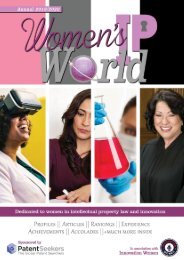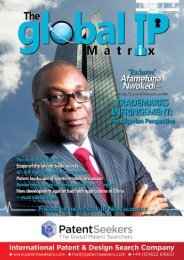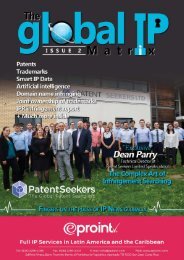Global IP Matrix - Issue 5
It has been a fantastic year for The Global IP Matrix magazine, thanks to all the efforts made by our contributors and to you, the reader for your continued support. We take great pleasure in putting together each issue of this publication, and we sincerely hope you enjoy this final issue of 2019. We have again, collaborated with some of the world's most influential IP law firms and businesses to bring you another eclectic mix of content, direct from the professionals working at ground level. We are already excited for the coming year and cannot wait to continue growing and evolving in our partnerships to bring you some exciting new features for 2020. Ms. Elvin Hassan Editor & Head of international liaisons
It has been a fantastic year for The Global IP Matrix magazine, thanks to all the efforts made by our contributors and to you, the reader for your continued support. We take great pleasure in putting together each issue of this publication, and we sincerely hope you enjoy this final issue of 2019. We have again, collaborated with some of the world's most influential IP law firms and businesses to bring you another eclectic mix of content, direct from the professionals working at ground level. We are already excited for the coming year and cannot wait to continue growing and evolving in our partnerships to bring you some exciting new features for 2020.
Ms. Elvin Hassan
Editor & Head of international liaisons
You also want an ePaper? Increase the reach of your titles
YUMPU automatically turns print PDFs into web optimized ePapers that Google loves.
A23V2002/00 Food compositions, function of food ingredients or<br />
processes for food or foodstuffs<br />
A61B5/14532 for measuring glucose, e.g., by tissue impedance measurement<br />
A61K36/481 Astragalus (milkvetch)<br />
use of needles and tubing, thereby lowering<br />
patient discomfort and increasing treatment<br />
compliance. Such innovative solutions have<br />
been shown to significantly lower the risk<br />
of developing complications resulting from<br />
diabetes through effective glycaemic control.<br />
However, these devices are not fully independent,<br />
and insulin contained within them needs to be<br />
replenished regularly; hence, future efforts may<br />
focus on exploiting advancements in stem-cellbased<br />
regenerative therapies to overcome these<br />
challenges.<br />
2. Keeping an eye on the sugar<br />
Figure 2. A heatmap of patent publications in the top 20 CPC classifications.<br />
Who are the current competitors?<br />
Despite the recent potential shift in focus away from pharmaceuticals, most identified areas over<br />
the last 20 years relate to medicinal preparations. This is reflected in Figure 3, wherein the landscape<br />
appears to be dominated by big pharmaceutical companies, which is not surprising considering its<br />
burden upon the healthcare system. The key assignee appears to be Merck Sharp & Dohme, which<br />
holds approximately 17% of the total patent filings in the area. However, it faces firm competition<br />
from Beijing Lvyuanqiuzheng Technology Development, which may be explained by China having the<br />
highest demand for novel solutions, as it has the highest population of diabetics in the world.<br />
Figure 3. Diabetes-related patent filings by the top 15 assignees.<br />
What are the innovations with the biggest potential impact?<br />
A search of the current literature around diabetes treatments uncovers a treasure-trove of innovation.<br />
We will now explore some of the most interesting technologies being developed that might help<br />
overcome the challenges posed by diabetes.<br />
1. An Artificial Pancreas?<br />
Enzyme based finger-prick tests have been the standard means of monitoring blood glucose levels.<br />
However, this process only gives limited insight into glycaemic changes and has been shown to have<br />
low compliance among diabetic patients, thereby translating into a growing need for technology<br />
that can improve glucose monitoring. This has recently been addressed by Medtronic’s development<br />
of the MiniMed 670G System. It is a smart insulin pump that automatically calculates and delivers<br />
an appropriate dosage of insulin, based on glucose sensor readings. A similar product that is<br />
particularly interesting has been designed by Omnipod, which is an external device that avoids the<br />
www.gipmatrix.com<br />
An interesting opportunity for easier and<br />
more effective glucose management has been<br />
investigated by Novartis and Google, wherein<br />
glucose is monitored through smart contact<br />
lenses. However, its application has been limited<br />
due to discomfort associated with the sensors<br />
and a lack of reliable glucose readings. Ulsan<br />
National Institute of Science and Technology<br />
appears to have made progress within this field,<br />
as it developed contact lenses comprising sensors<br />
made of stretchable and transparent materials,<br />
which circumvent previous limitations. The new<br />
lenses also comprise an integrated antenna for<br />
wirelessly transmitting data in real-time, which<br />
makes the previously cumbersome process of<br />
blood glucose level monitoring significantly<br />
easier.<br />
3. Deciphering the genetic<br />
enigma of diabetes<br />
The genetic code governs all biological systems.<br />
Our understanding of the human genome has<br />
huge implications for the future of healthcare, as<br />
many patients exhibit a heterologous response<br />
to treatment. It also has the potential for the<br />
discovery of predictive biomarkers that could<br />
improve preventative measures through the<br />
development of genotype tailored lifestyle<br />
programmes. Despite the potential benefits,<br />
developments in this field appear to be ongoing.<br />
This is illustrated by a recently granted patent<br />
(EP2609218B1) that appears to disclose a<br />
method of diagnosing an individual’s genetic<br />
predisposition to developing diabetes, while<br />
The University of California appears to have<br />
discovered genetic variants that affect response to<br />
Metformin treatment. These examples provide us<br />
with an insight into how a better understanding<br />
of our genome could lead to a more personalised<br />
treatment approach, which has the potential to be<br />
more cost-effective.<br />
Conclusion<br />
Worldwide prevalence of diabetes is a growing<br />
challenge for the future of healthcare. It is,<br />
therefore, no surprise that big pharmaceutical<br />
companies dominate the market. While there<br />
is an absence of a definitive cure, recent efforts<br />
have been made in effectively managing<br />
glycaemic levels, which has significantly<br />
reduced the mortality rate and economic<br />
burden of diabetes. Perhaps the lack of<br />
apparent activity in applying genomic data<br />
to the development of preventative measures<br />
may present a gap in the market that could<br />
help overcome challenges posed by diabetes.<br />
Nevertheless, the dynamic diversity of<br />
innovation within this field makes it difficult<br />
to ascertain the direction of future activity. It<br />
will be exciting to see the next move of the key<br />
players in the fight against diabetes.<br />
5












